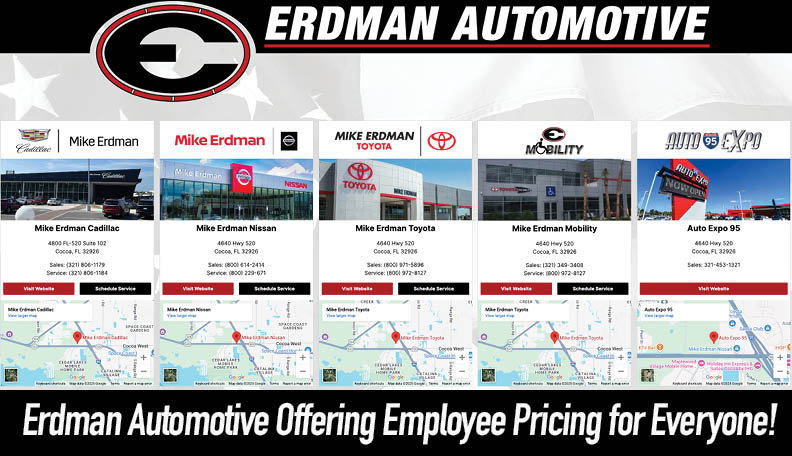7 Signs Your Business Needs a Custom Application Right Now
By Space Coast Daily // February 12, 2025

Today’s very digital business world, particularly to get their operations more streamlined, communicate to their customers better, or stay competitive, has made custom apps quite important for businesses to use to achieve these goals.
Additionally, businesses often fail to realize that while there are so many off-the-shelf solutions floating around the market, it is perhaps more appropriate to invest in custom development rather than just get an out-of-the-box solution.
When developers build generic apps, they have a purpose, but rarely do they deliver app building that optimally fits the customer journey as an entire offering into the organization that requires unique and tailored needs. Ill-fitting solutions have been accumulating over time, leading to friction, no growth, and core business limitations.
For companies that are still doing things the old traditional way, applications that are more tailored can be harder to understand when you know you need one, but what that application is can be really difficult to determine. However, there are several clear indicators that point to an immediate need to level up technology with a custom-built solution.
1. Your Systems Are Not Connected
For most modern companies, business activities span multiple departments, teams, and systems. When these systems do not communicate with each other, data becomes siloed, productivity takes a hit, and gaining meaningful insights becomes extremely difficult.
Some signs your systems are disconnected:
- Team members manually transfer data between apps or upload and download spreadsheets. This duplicate data entry opens the door for human error.
- Leadership does not have clear visibility into real-time sales figures, support ticket volumes, project progress, and other vital statistics.
- There are discrepancies between reports from different departments because data is not synced across systems.
- Customers frequently reference previous correspondences your team cannot access or did not receive.
Without a “source of truth” or single integrated view of business data and activities, leadership essentially manages departments, teams, and processes unthinkingly. This lack of data-driven decision-making also trickles down to customers not receiving a continuous experience. Companies looking for more info on improving data accessibility can explore integration solutions tailored to their needs.
A custom application can act as an orchestration layer to eliminate data silos and centralize systems. This provides transparency across the organization so bottlenecks can be identified early and resources properly allocated. Leadership gains access to a single dashboard providing real-time insights. And from a customer perspective, support agents and other front-line employees can immediately access the full history and context.
2. Your App Is Not Mobile Friendly
Considering how much business is now conducted on mobile devices, applications without responsive mobile interfaces severely limit organizations in numerous ways, including:
- Restricted access for remote employees and field teams. Teams without laptops rely on mobile devices to stay connected and access business data on the go. Non-mobile apps block remote workers from getting their job done efficiently.
- Missed sales opportunities. According to Google, more than 50% of searches now come from mobile devices. When a potential customer visits your website and finds navigation difficult on their phone, you are handing revenue to mobile-friendly competitors.
- Poor customer experiences. Customers expect seamless experiences across channels. Clunky mobile interactions lead to frustration and churn over time.
Evaluating your tech stack for mobile compatibility identifies weak points that are ripe for transformation via custom applications. Modern apps are built mobile-first, ensuring convenience and continuous workflows across devices.

3. Your App Is Not User-Friendly
Technology should serve end users rather than create additional obstacles, which is, unfortunately, the case with many off-the-shelf and legacy solutions. Hard-to-use applications directly translate to reductions in productivity, quality, and satisfaction over time.
Common signs your systems come up short on usability include:
- Team members require extensive training to complete basic tasks.
- Your app has an outdated interface with small text, confusing menus, and poor navigation.
- There are frequent questions or complaints regarding your application.
- Employees develop inefficient manual workarounds or processes to avoid using your official system.
- Usage data shows low employee adoption or high drop-off rates.
Building a custom solution focused directly on your users’ needs and preferences leads to faster adoption and more impactful results across metrics from sales to customer satisfaction.
4. Your App Lacks Customization
Even the most robust generic solutions on the market cater to the average use case rather than specialized requirements. At some point in the growth cycle, most companies outgrow one-size-fits-all platforms.
Your business may have unique needs related to:
- Specific data or integrations. Pulling in niche data sets not supported by off-the-shelf tools.
- Advanced configurations. Customized rule sets and permissions matrices are required.
- Process automation. Streamlining workflows with tailored logic unavailable in generic apps.
- Branded design. Aligning tools with brand guidelines for consistent customer and employee experiences.
Relying on apps lacking customization forces your business to use technology’s way of operating rather than technology enhancing your business model and processes. The flexibility of the solution offers the possibility of having custom applications that can have whatever visual design, details for integration, data structure, and business rules work perfectly with you.
5. Your App Limits Future Innovation
Even if all your current needs are met, choosing applications lacking scalability eventually curbs process improvements down the line.
Most of the generic solutions box companies into predefined features, workflows, and data structures. Things are changing rapidly in terms of business needs and the competitive landscape. It will not take long; what will suffice today will not sustain long-term market leadership.
Some indicators your systems restrict growth rather than fuel it:
- Feature requests are turned down by your technology provider, forcing your team to settle for the status quo.
- Upgrades are delayed or limited compared to what the market demands.
- Your platform lacks APIs and extension points for deep customization.
- You find yourself manually circumventing the application’s rigid constraints. Workarounds provide temporary relief but limit visibility, governance, and further innovation.
By right design, custom enterprise applications are architected to be adaptable platforms rather than inflexible products. The technical foundation and integration capabilities afford the leaders of business to actively control the course solutions taken in adapting to new needs, thus avoiding being immediately constrained to predefined routes.
This future-proofing shields companies from disruption, keeps innovation on pace with market demands and unlocks game-changing technology, such as AI/ML data science capabilities.
6. You Are Missing Valuable Data Insights
Business intelligence and reporting enable data-driven decision-making, which is an absolute must-have but not a nice one for leading modern enterprises. However, despite all that, many businesses stop there and do not achieve the real value of being able to utilize data to learn how to inform strategy and operations.
If any of the below scenarios apply to your current situation, then you must immediately consider putting taps on custom development in advanced analytics and business intelligence.
- Basic reporting only scratches the surface in terms of answering strategic questions.
- Data science and analytics talent constantly run up against application limitations.
- Leadership still relies heavily on gut feelings rather than data insights.
- Reports take too long to create or lack flexibility.
- Your application does not capture the full breadth of valuable business data.
Think beyond reports and dashboards with out-of-the-box tools. Custom analytics development unlocks advanced machine learning capabilities to spot trends, make predictions based on internal and external data, identify growth opportunities and risk factors, and guide innovations.
7. You Have Outgrown Your App’s Cost Structure
Many startups and growth-stage companies lean heavily on spreadsheets, niche tools, and “good enough” apps in the early days. However, over time, manual processes do not scale, and low-priced generic platforms become less economical.
Factors indicating you have outgrown basic solutions from a cost perspective:
- Wasted productivity. Manual tasks and data wrangling between disconnected systems squander talent hours better spent on high-impact initiatives.
- Revenue leakage. With limited visibility and governance, you will miss renewals, quote inaccuracies, and customer-facing errors, all of which are preventable sources of lost revenue.
- Inefficient allocations. People decide to invest based on their gut instead of running analytics.
- Opportunity costs. Without the ability to customize, extend, and do advanced analytics, money-saving innovation and intelligent automation are out of reach.
Evaluating the hard and soft costs across these areas frequently reveals an enterprise-grade custom application delivers a far quicker ROI compared to further extending generic systems and manual processes.
The key is to take a long-term view when calculating costs and benefits. Both of these inflate the upfront investment to make you draw back from sticker shock. However, custom solutions have delivered exponential value over the years by delivering innovations, efficiencies, and revenue channels that cannot be achieved otherwise.
When Is the Right Time to Invest in Custom Application Development?
Determining the exact right moment to pull the trigger on custom software development is equal parts art and science for most organizations.
The decision depends in many ways on strategic priorities, growth stage, budget, and other business factors unique to each company.
However, the seven signs covered in this guide provide strong signals your organization could benefit enormously from custom applications right now based on:
- Technology limitations curbing productivity, decision-making, and innovation
- Inefficiencies driving up costs directly and through lost opportunities
- Poor experiences frustrating employees and customers
Ideally, businesses conduct regular technology strategy reviews as needs shift over time. However, if two or more of the issues discussed resonate with their current situation, custom software development warrants in-depth exploration for most enterprises.
Some additional perspectives to help guide technology investment decisions:
Adopt a Platform Mindset
Think of custom applications as long-term platforms supporting continuous improvement rather than one-off projects with a limited lifespan.
Taking this platform approach when scoping requirements future-proofs development and maximizes ROI across months and years of utilization.
Right from the start, prioritize flexibility, extensibility, and integration capabilities. This will reduce costs later on as new cases or applications emerge.
Focus on High-Impact Areas
Not all business systems require custom development or offer equal return potential.
When assessing technology gaps and frustrations, focus first on fixing pain points directly tied to:
- Improving employee productivity and satisfaction
- Increasing sales, conversions, and revenue expansion
- Reducing costs through enhanced efficiency and automation
- Strengthening security and compliance
- Delivering differentiated customer experiences
These high-impact areas typically deliver strong and fast ROIs once addressed through strategic custom application development initiatives.
Take an Iterative Approach
For larger initiatives, an iterative, agile approach allows companies to tap into custom development benefits sooner rather than later.
Prioritizing foundational capabilities upfront while mapping out a longer-term platform vision balances short-term wins with long-term scalability.
As an example, a custom CRM could launch with contact management and accounts as the first phase. Additional functionality like opportunity management, customer service, and marketing automation rolls out over subsequent releases.
This strategy rapidly demonstrates value to justify further investment. At the same time, it allows the technology foundation to solidify before deploying more advanced components.
Key Takeaways
Here are the big ideas to walk away with when assessing the need for custom software applications:
- Generic apps rarely meet all the boxes in the long run as requirements change and companies differentiate.
- Poor usability, custom productivity limitations and innovation, and disconnected systems.
- A competitive advantage that can’t be exploited by harnessing data only goes to waste.
- When it comes to manual, restrictive platforms, hard and soft costs accumulate.
- Mobile-friendliness, extensibility, and high-impact use cases are the strong ROI factors.
- The iAn iterative approach is beneficial to companies that want to reap the benefits earlier and lay a foundation for their strategy.
Today, technology cannot stand still for the world’s enterprises, which are experiencing rising customer expectations, market disruptions and emerging innovations like artificial intelligence. Transformation and resilience are best accelerated by custom application development until those business requirements change.
We hope this helped articulate how a small (or not so small) portion of the way to empower your employees, delight your customers and deliver growth in the coming years may be to invest in custom systems now.












